
Pool of Radiance is a role-playing video game developed and published by Strategic Simulations, Inc (SSI) in 1988. It was the first adaptation of TSR's Advanced Dungeons & Dragons (AD&D) fantasy role-playing game for home computers, becoming the first episode in a four-part series of D&D computer adventure games. The other games in the "Gold Box" series used the game engine pioneered in Pool of Radiance, as did later D&D titles such as the Neverwinter Nights online game. Pool of Radiance takes place in the Forgotten Realms fantasy setting, with the action centered in and around the port city of Phlan.
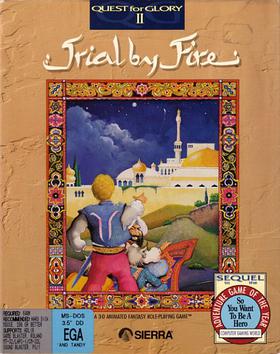
Quest for Glory II: Trial by Fire is the second video game in Sierra On-Line's Quest for Glory series, and the sequel to Hero's Quest: So You Want to Be a Hero.

Curse of the Azure Bonds is a role-playing video game developed and published by Strategic Simulations in 1989. It is the second in a four-part series of Forgotten Realms Advanced Dungeons & Dragons Gold Box games, continuing the events of Pool of Radiance.
The Adventure Game Interpreter (AGI) is a game engine developed by Sierra On-Line. The company originally developed the engine for King's Quest (1984), an adventure game that Sierra and IBM wished to market in order to attract consumers to IBM's lower-cost home computer, the IBM PCjr.

Manhunter: New York is a post-apocalyptic adventure game designed by Barry Murry, Dave Murry and Dee Dee Murry of Evryware and published in 1988 by Sierra On-Line. A sequel, Manhunter 2: San Francisco, was released in 1989.

The Colonel's Bequest is a character-driven graphic adventure game by Sierra On-Line featuring the character of Laura Bow. It was developed for MS-DOS in 1989. Ports for Amiga and Atari ST were released in 1990. It was the first of the short-lived Laura Bow Mysteries series created by Roberta Williams, which used many elements from the game Mystery House. The Colonel's Bequest was created with SCI0, and employed 4-bit color and a typing interface. Its sequel The Dagger of Amon Ra was released in 1992.
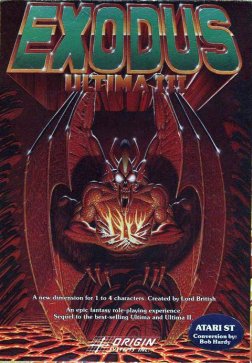
Ultima III: Exodus is the third game in the series of Ultima role-playing video games. Exodus is also the name of the game's principal antagonist. It is the final installment in the "Age of Darkness" trilogy. Released in 1983, it was the first Ultima game published by Origin Systems. Originally developed for the Apple II, Exodus was eventually ported to 13 other platforms, including a NES/Famicom remake.

Odyssey: The Compleat Apventure was a video game written by Robert Clardy and released by Synergistic Software in 1980. It was created for the Apple II platform and is considered one of the first microcomputer-based role-playing video games. The title was intentionally misspelled; Apventure is a reference to the Apple computer while "Compleat" is simply an Archaic spelling of the word "complete" meant to match the feel and setting of the game.
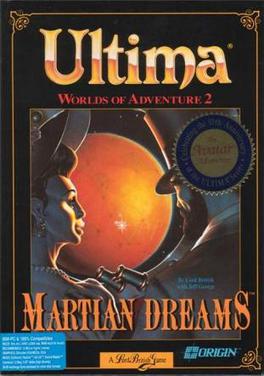
Ultima: Worlds of Adventure 2: Martian Dreams is a role-playing video game, part of the Ultima series, published in 1991, and re-released for Windows and Mac OS via GOG.com in 2012. It uses the same engine as Ultima VI: The False Prophet, as did Worlds of Ultima: The Savage Empire.

Buck Rogers: Countdown to Doomsday is a role-playing video game set in the Buck Rogers XXVC universe. It was published in 1990 by Strategic Simulations for MS-DOS, Commodore 64, and Amiga. A Sega Genesis version was released in 1991. Buck Rogers: Matrix Cubed is the 1992 sequel.

The Pandora Directive is the fourth installment in the Tex Murphy series of graphic adventure games produced by Access Software. After its creators reacquired the rights to the series, it was re-released on Good Old Games in July 2009.
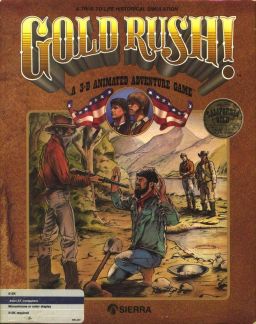
Gold Rush! is a graphic adventure video game designed by Doug and Ken MacNeill and originally released by Sierra On-Line in 1988.

The Magic Candle: Volume 1 is a role-playing video game designed by Ali Atabek and developed and published by Mindcraft in 1989.

Leisure Suit Larry Goes Looking for Love (in Several Wrong Places) is the second game in the Leisure Suit Larry series of graphical adventure games, designed by Al Lowe and published by Sierra On-Line in 1988. Like its predecessor, Leisure Suit Larry in the Land of the Lounge Lizards, it was developed for multiple platforms, including MS-DOS, Atari ST and Amiga. It utilizes Sierra's Creative Interpreter (SCI0) engine, featuring 16-color EGA graphics and a mouse-based interface for movement. The story continues the exploits of Larry Laffer, who becomes stranded on a tropical island during an ill-fated vacation.
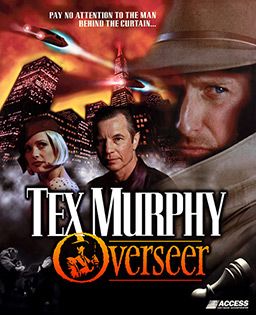
Tex Murphy: Overseer is the fifth installment in the Tex Murphy series of graphic adventure games produced by Access Software. In it, the player controls Private Investigator Tex Murphy as he recounts the story of his first case to his girlfriend, Chelsee Bando. Like the previous two Tex Murphy games, Under a Killing Moon and The Pandora Directive, Overseer combined the use of full motion video (FMV) with 3D environments.

Wizardry V: Heart of the Maelstrom is the fifth scenario in the Wizardry series of role-playing video games. It was published in 1988 by Sir-Tech for the Commodore 64, Apple II, and IBM PC compatibles. A port for the Super Famicom and FM Towns was later developed and published by ASCII Entertainment in Japan. Wizardry V was released in the US for the Super NES by Capcom in 1993, and subsequently re-released for the Satellaview subsystem under the name BS Wizardry 5.
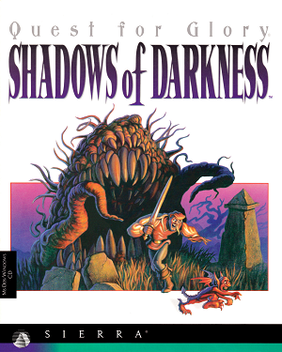
Quest for Glory: Shadows of Darkness is an adventure game/role-playing video game hybrid. It is the fourth installment of the Quest for Glory computer game series by Sierra On-Line. It was the first and only game of the series to drop the numerals from the title.

Quest for Glory: So You Want to Be a Hero is a 1989 adventure game/role-playing game hybrid, designed by Lori Ann Cole and published by Sierra On-Line for MS-DOS. It is the first game in the Quest for Glory series, and has been credited for being a genre-defining game, as it tried to mix graphical adventure gaming with role-playing-like elements such as statistic building that would actually affect the ability to accomplish certain parts of the game. The game has a satirical and silly tone. Ports for the Amiga, Atari ST, and NEC PC-9801 were released in the early 1990s. A VGA remake, titled Quest for Glory I: So You Want to Be a Hero, was released in 1992 for DOS and later in 1994 for Mac OS.

Space Quest III: The Pirates of Pestulon is a 1989 graphic adventure game by Sierra On-Line, and the third game in the Space Quest series. Players assume the role of Roger Wilco, a lowly space janitor, who becomes involved in rescuing a pair of computer programmers from a sinister video game company. The game received positive reviews from critics, and contributed further to the series' commercial success for Sierra. A sequel, Space Quest IV, was released in 1991.
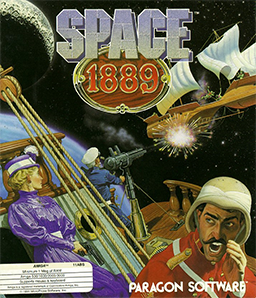
Space: 1889 is an adventure game developed by Paragon Software and published in 1990 for Amiga, Atari ST, and MS-DOS.



















